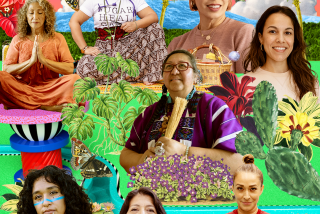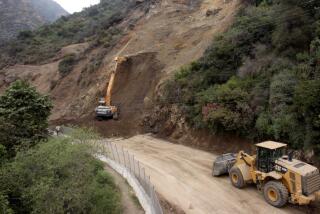There Are Artists, Commuters, New Agers, Graying Hippies and Business People, and They All Love Topanga Canyon for Its . . . : Country Living
Just the other day, a Topanga Canyon woman found a rattlesnake in her kitchen. This troubled her considerably but, she reasoned, a rattlesnake is a living thing, one of Nature’s own, and as such, its rights are to be respected. No point in overreacting and upsetting the cosmos.
So the woman summoned her husband, who used a pool skimmer to nudge the serpent out to the patio. But when he tried to shoo the rattler back into the brush, where it might naturally balance the gopher population, the darn thing just hissed and looked at the humans as if they were the problem. This snake wasn’t moving.
Only then did they decide to kill it. And that is why they don’t want their names in the newspaper, so heavy is their shame. What would their neighbors think?
This tale is not meant to imply that all Topanga Canyon residents are hypersensitive souls who feel guilty ridding their homes of deadly animals. That stereotype is as overwrought as all the others. Not all Topangans are scruffy, gray-haired hippies who subsist on sprouts and marijuana. Not all practice astrology, numerology, iridology or channeling. Not all swear by the power of crystals, eagle feathers or white sage. Not all run around naked, belong to alternative religious sects or contribute screenplays to the cultural elite. And only a few say they saw a UFO swoop through their canyon in the pre-dawn hours of Sunday, June 14, 1992. (It was, by some accounts, Topanga’s sixth such visitation.)
But in this rugged canyon fringed with oak and sycamore, along a creekside highway that connects the San Fernando Valley with the Pacific Ocean, a Bohemian spirit prevails whether the issue is rattlers or reincarnation. (Kill a snake and you may be a gopher next time around.) ‚ÄúHey,‚ÄĚ Topangans like to say, ‚Äúif it works for you. . . .‚ÄĚ
So why is it, then, that some Topangans get touchy about their community’s famous eccentricities?
‚ÄúWe‚Äôre not all sitting up here staring at our crystals,‚ÄĚ snaps Susan Petrulas Nissman, a political activist.
‚ÄúTo me, Topanga is not particularly New Age, but outsiders think it is,‚ÄĚ adds Marty Brastow, an agent with Rainbow Real Estate and a member of the Town Council. ‚ÄúPeople go to the Inn of the Seventh Ray‚ÄĚ--the canyon‚Äôs famous, unabashedly New Age restaurant--‚ÄĚand they think that‚Äôs Topanga.‚ÄĚ
Colin Penno, editor of the biweekly Topanga Messenger, tends to agree. ‚ÄúThe Inn of Seventh Vegetable,‚ÄĚ he says disdainfully, is more of a tourist spot than a local hangout, such as Rocco‚Äôs or the Fish Market.
What sets Topanga apart, Penno suggests, is more of a respect for the natural than the supernatural. Nowhere else, he says, can one be so close to nature and so close to metropolitan Los Angeles. So Topangans tend to be protective of the canyon, treating it as their own talisman, a good luck charm of a place.
Topangans talk about the small-town virtues. Downtown, such as it is, is located at the fork of Topanga Canyon Boulevard and Old Topanga Canyon Road, both of which follow the creekbed that nature created eons ago. Here you’ll find the post office, a country store, a small shopping center, a few vagrants and the boxcar that houses Topanga Homegrown.
Folks who live in restored cabins and more splendid homes scattered about the hillsides get to know each other at the elementary school. Sometimes it seems that everybody knows everybody else. People exchange four-digit phone numbers; the prefix is always 455.
It‚Äôs an artsy place. Ainsley Pryor, proprietor of the New Canyon Gallery, made a lot of friends when she staged an exhibit of portraits of local folks by local artists. ‚ÄúPeople would come in and say, ‚ÄėHey, I know this guy! There‚Äôs Bob, and look, there‚Äôs Ray over there!‚Äô ‚ÄĚ The first work sold was a caricature of a wild-eyed, wild-haired girl with her tongue sticking out. The artist was Jody Roberts, a deaf and mute Topanga fixture who tools about the canyon in a old lime-green VW van.
Topanga may be a small town, but it is more the irreverent Americana of a Jody Roberts than the homespun visions of a Norman Rockwell. The town doesn’t just have kids skinny-dipping in the local swimming hole, it has Elysium Fields, the nudist camp that is involved in the adopt-a-highway clean-up program. And while Topanga has its conventional doctors, it also has its shamans.
Robert Tarumoto, for example, is a shiatsu masseur who uses quartz and, sometimes, eagle feathers in his treatments. Now he‚Äôs boning up on iridology--diagnosing a person‚Äôs ailments by studying their eyes. He knows a dental hygienist in the canyon who does ‚Äúsound therapy,‚ÄĚ treating clients with the tonal vibrations of crystal bowls.
Over-the-counter medicines are available in stores, but Topangans and tourists may also try their luck with crystals at the Inn of the Seventh Ray‚Äôs gift shop, or the Budget Rock Shop, a little roadside shack. A sign guards the shop against New Age thieves: ‚ÄúIf I do not see you steal, the Angels will . . . and your karma will come back to you 10,000 fold.‚ÄĚ (Perhaps you will come back as a dirt clod.)
There is, of course, no such thing as a typical Topangan, but Susan Nissman is a likely suspect. She gave up the advertising racket to live in the canyon full-time, devoting her time to community activism, ceramics and raising her two kids. Her husband makes the daily commute to the city.
Nissman has experienced the serendipity that seems common in Topanga. Determined to use natural childbirth, Nissman grew disenchanted with her obstetrician’s authoritarian ways during her first pregnancy. One day she vented her troubles to a neighbor, the caretaker at a rock star’s home. It just so happened that the neighbor was a midwife. She would later deliver Nissman’s child at home. The experience was so wonderful, Nissman says, that she decided to deliver her second at home as well.
She fears that outsiders see Topangans as ‚Äúa lot of dropouts, leftovers from the ‚Äė60s. And that means we‚Äôre half brain-dead.‚ÄĚ The Topangans that Nissman describes are a pioneer breed hardened by battles with fire, floods and developers who‚Äôd like to carve up their treasured canyon. They are individualists, she suggests, who greatly respect the rights of others.
Consider the Topanga Labor Exchange. When Topangans last year started complaining that day laborers from Mexico and Central America who gathered along the highway and camped out in the hills created a hazard to themselves and others, local activists established the labor exchange as a gathering place off the highway. At least part of the problem was solved, Nissman says, although many still worry about the increased fire risk.
Crystals were not employed in this endeavor. Nissman herself chuckled and expressed skepticism about the supposed power of the stone. Then she admitted that Tarumoto, after a treatment, places a piece of quartz over her heart--‚ÄĚI mean, it can‚Äôt do any harm.‚ÄĚ
But Nissman professes no doubts whatsoever about ‚Äúthe energy of white sage.‚ÄĚ Some Topangans, like the Chumash Indians before them, believe the abundant native plant possesses purifying qualities when used as incense.
Louise York, editor of a soon-to-be-published history of Topanga Canyon, represents an older breed of residents who take all this local color with amusement. She and her husband Ken, a retired law professor who taught at UCLA and Pepperdine, moved here in 1955, raising four sons when the canyon was still considered ‚Äúthe sticks.‚ÄĚ
In 257 pages, ‚ÄúThe Topanga Story‚ÄĚ tells of the canyon‚Äôs distinctive geography, archeology, flora and fauna. The first homesteaders arrived in the 1880s, the first post office and general store in 1908. Once primarily a weekend retreat for city dwellers, Topanga attracted more full-time residents after World War II. Telephone service didn‚Äôt arrive until the 1940s. Although the canyon‚Äôs beauty and quiet has long attracted artists and writers, it took the hippies to alter Topanga‚Äôs reputation forever. ‚ÄúThere‚Äôs a great harmonic convergence up here,‚ÄĚ Ken York jokes.
Louise York, for one, professes no firsthand experience with white sage. ‚ÄúNever even heard of it,‚ÄĚ she admits. ‚ÄúNo, I‚Äôm kind of a conventional person, living a conventional life.‚ÄĚ
If the Yorks represent conventional yin of Topanga, then Lucille and Ralph Yaney may be the ethereal yang. The Yaneys--he‚Äôs a psychiatrist, she‚Äôs a psychotherapist--founded ‚ÄúThe Inn of the Seventh Ray‚ÄĚ in 1975 on a property that used to house an old Four Square Baptist Church. Although the Yaneys have since followed the controversial spiritual priestess Elizabeth Clare Prophet (known as Guru Ma) to Montana, Lucille shuttles back and forth to tend to the inn, which recently worked itself out of bankruptcy.
She grimaces and sighs in reaction to the criticism that the restaurant has become more of a caricature, rather than a true symbol, of Topanga. Quite a few Topangans, she says, frequent the inn. And Yaney is not about to apologize for following ‚Äúthe spiritual path.‚ÄĚ
She pauses between bites of a macrobiotic vegetarian version of a Philly cheese steak. ‚ÄúYou want to see a miracle?‚ÄĚ she asks.
She points to an old oak angling out over of Old Topanga Creek, dry since spring. The tree’s trunk used to grow sideways out of the bank, extending across the creek bed. During a raging storm in 1982, Yaney recalls, she got a frantic phone call from the restaurant manager. Flooding had destroyed several homes upstream; now the debris was piling against the tree and the rising tide threatened to wash out the restaurant.
The manager wanted permission to chop down the tree, but Yaney says she was more concerned with his safety. ‚ÄúI told him we needed to call on the Nature Spirits.‚ÄĚ
Even before she was off the phone, Yaney says, a branch snapped and the inn was saved.
Down the road at Rainbow Realty, Marty Brastow smiles and shrugs off the metaphysical stuff. Nope, she declares flatly, most Topangans ‚Äútend to be down to earth rather than cosmic.‚ÄĚ Even with real estate slumping, it takes a professional‚Äôs income to buy in Topanga, she says. ‚ÄúThey don‚Äôt have time to be New Age.‚ÄĚ
Just then a house-hunter walks in, seeking the implausible--a fixer for $250,000. Brastow suggests that she drive out to a shack offered at $275,000. Brastow gives her directions, guiding her to a local landmark.
‚ÄúDo you know where the Buddha is?‚ÄĚ
More to Read
Sign up for Essential California
The most important California stories and recommendations in your inbox every morning.
You may occasionally receive promotional content from the Los Angeles Times.










